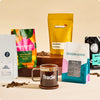Making espresso? It’s not complicated, it just takes a little practice! When I was a barista, the thought of making espresso at home, without equipment that costs tens of thousands of dollars and without being paid to do it exactly right was terrifying to me. But after years of making espresso on various home machines in the Trade office I’m happy to report that it’s totally possible to pull delicious shots on many different kinds of machines. Here's a basic tutorial to get you going:
-
Wipe out your portafilter basket with a dry rag.
-
Fill (but don’t overfill) your basket with finely ground coffee. I like brewing using around 18 grams of coffee, but different machines come with different size baskets, and you definitely shouldn’t jam in way more coffee than your basket can take just to hit a recipe.
-
Level your grinds. There are several ways of doing this, from using your finger to tapping your portafilter to using a fancy distribution tool. Regardless, you want your grinds to look relatively level before tamping.
-
Tamp! How hard you tamp is important, but most important is that you’re doing so consistently. Just press down using your body weight, not just your wrist, and you’ll be a-ok.
-
Run a second or two of water through your machine to make sure the grouphead is warmed up.
-
Lock your portafilter into your machine.
-
Start brewing!
-
Some machines are programmed to put out a certain amount of water, if you have one of those, that’s it! If you’re all the way on the other side of the effort spectrum and you’re weighing both your coffee and your shots pulling a shot that weighs twice as much as your dose of coffee (ex. 18g of coffee, 36g shot weight) (the pros often refer to this as 18g in, 36g out) is a good starting point. If you have neither an auto-programmed shot button nor a scale, just stop when it looks the size of a normal espresso shot. You’ve seen those before! I trust you!
That’s it, you’re done. Enjoy your shot!
But...
...Espresso is never truly done, and now is the time to reflect on how it went so your next shot can taste more like the way you want it to taste.
We haven’t talked about time yet, and though I think focusing on the amount of coffee and water you’re using is more important, you do want to make sure your shots aren’t running too fast or too slow. If you’re pulling a pretty standard-sized shot and it zooms through in 10 seconds, that’s probably too fast to get all the good flavors out of that coffee and into your cup. If, on the other hand, the espresso is dripping at a glacial pace and takes 50 seconds to drip through, it’s likely to be quite bitter.
The solution? Assuming you’re grinding your own coffee, you can adjust the grind size. Grinding finer will put up a little more resistance and make water go through your espresso much slower. Grinding coarser, on the other hand, will speed up the flow of water through any given dose of coffee. Changing the grind size will also affect flavor. If your coffee tastes too sour, grinding finer could help. If it’s tasting too bitter, grinding coarser could work.
Now, onto your next shot, and the one after that, and thousands more. Espresso is an adventure and this is only the beginning.
For more information:
-
A more detailed guide to getting your espresso right: the art of dialing in






